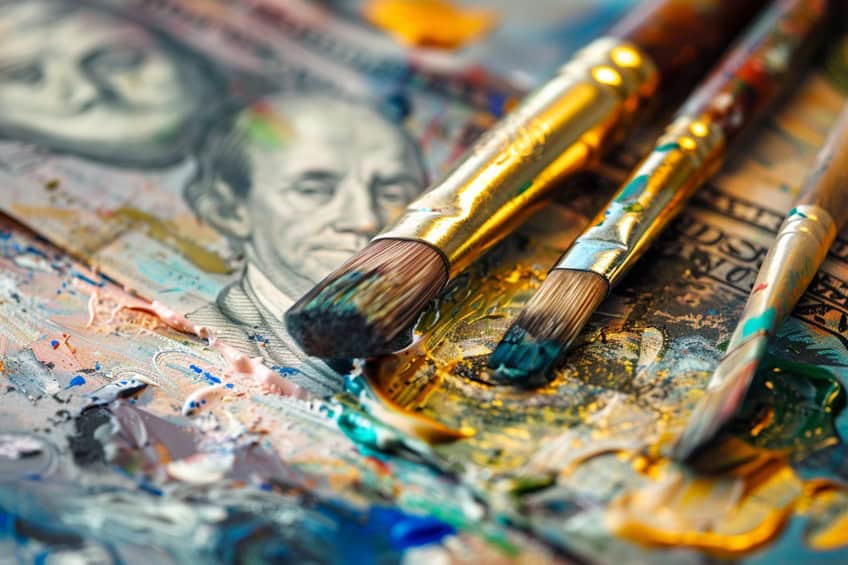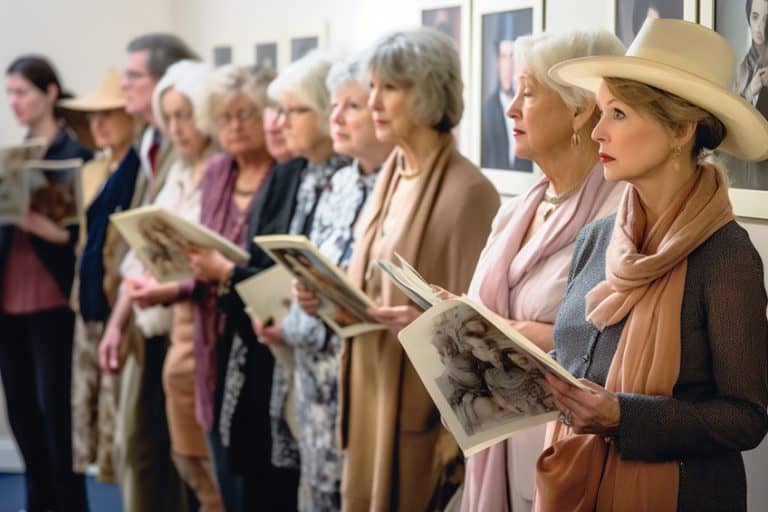How to Invest in Art – A Complete Guide
Investing in art has become an appealing avenue for both seasoned collectors and newcomers looking to diversify their portfolios. Unlike traditional investments, art offers the unique advantage of aesthetic enjoyment, historical value, and cultural significance, while potentially appreciating in financial value over time. From paintings and sculptures to contemporary digital art, understanding the art market, trends, and the factors that influence artwork value is crucial for making informed decisions. This guide will provide insights on how to navigate the art world, assess investment opportunities, and build a well-rounded art collection for long-term growth.
Key Takeaways
- Art provides a unique blend of aesthetic enjoyment and investment potential.
- Understanding market trends and investment types is crucial for success.
- Informed decisions can lead to both financial gain and cultural enrichment.
Understanding the Art Market
Art has emerged as an intriguing alternative investment, generating interest among seasoned investors and newcomers alike. Unlike traditional assets like stocks or bonds, art offers aesthetic pleasure along with potential financial gain. Investing in art is not just about acquiring pieces you love; it’s also about making informed decisions that can enhance your portfolio.
Participation in the art market involves various avenues such as purchasing individual works or joining art investment funds.
Determining the right strategy requires understanding the nuances of the art world and recognizing the risks and rewards associated with each type of investment. As with any investment, due diligence is crucial to avoid pitfalls and make profitable choices. Navigating art ownership involves more than just buying and selling; it requires an appreciation of market trends, value assessments, and the cultural significance of the works. Balancing personal taste with market dynamics can be a rewarding endeavor that enriches both financially and culturally.
Primary vs. Secondary Market
The primary market is where art is sold for the first time. Pieces often come directly from the artist’s studio and are sold via galleries or dealers. This market helps to establish the initial value of an artist’s work. The secondary market, however, involves previously sold artworks. These pieces gain value through trading among collectors, galleries, and auction houses. The market value here typically reflects an artist’s established reputation and demand.

Buyers interested in new and emerging artists often explore the primary market. Those looking for investment opportunities and recognized works focus on the secondary market. Understanding the distinctions between these markets can guide investment decisions effectively.
Role of Auction Houses and Art Galleries
Auction houses like Sotheby’s and Christie’s play a critical role in shaping art market dynamics. They often handle high-profile sales and attract serious collectors as well as investors. Auctions can set price benchmarks and reveal trends in what art styles or artists are currently valued.
Art galleries are essential for artist exposure, primarily in the primary market. They help cultivate artists’ reputations and develop relationships with collectors.
By hosting exhibitions, galleries introduce art to a broader audience, helping to increase an artist’s market value. Both venues influence art prices and collector behavior. Auction results and gallery exhibits can provide insights into market health and trends.
Insight into Global Art Market Trends
The global art market is influenced by economic factors, cultural interests, and technological advances. Recent reports highlight a strong recovery post-pandemic, with significant contributions from regions like the U.S., Europe, and Asia.

Digital platforms and online sales have become substantial, expanding access to global buyers. Moreover, emerging markets are playing a growing role in increasing competition and diversity. Understanding these trends can help investors and collectors identify opportunities and risks. Market adaptability, influenced by cultural preferences and economic shifts, remains crucial in navigating the art world’s complexities.
Types of Art Investments
Investing in art offers various avenues, allowing individuals to tailor their strategies and interests. From owning physical artworks to digital innovations, each type of investment has unique characteristics and appeals.
Fine Art and Blue-Chip Art
Fine art represents traditional investment often focused on renowned artists. These artworks, known for their historical importance and desirability, include famous blue-chip artists such as Picasso and Warhol. Blue-chip art typically holds steady value over time, making it an attractive option for those seeking stability in their investments. Blue-chip artworks are often priced in the millions, requiring significant upfront capital.
For those unable to afford entire pieces, platforms like Masterworks offer fractional shares. These shares allow investors to gain exposure to blue-chip art with less initial financial commitment.
Contemporary and Emerging Artists
Contemporary art encompasses pieces created from the late 20th century to today. It reflects current cultural trends and ideas, often making it a more dynamic investment. Emerging artists often fall within this category, offering opportunities for high growth as they gain recognition.

Investing in contemporary or emerging artists can be riskier, as their market values are less established. However, this category can yield substantial returns if the artist becomes highly sought after. Careful research and familiarity with current trends are essential for success in this area.
Digital Art and NFTs
Digital art has rapidly evolved with the advent of blockchain technology, leading to the rise of non-fungible tokens (NFTs). NFTs are unique digital assets representing ownership of art, music, or other media. This format offers a new avenue for investing, with examples like Beeple’s digital artwork selling for millions. NFTs provide investors with a way to speculate on the future value of digital art. Many platforms facilitate the purchase and sale of NFTs, enabling easy entry into the market.
Given the volatility in this space, investors should stay informed about technological advances and market trends.
Art Funds and Fractional Ownership
Art funds pool resources from multiple investors to purchase a diversified portfolio of artworks. This approach mitigates individual risk and allows for expert management. Art funds manage acquisitions, sales, and market strategies, which can be advantageous for those preferring a hands-off investment method.

Fractional ownership involves buying shares of a single piece or a collection. This can be done through platforms like Masterworks, providing access to high-value art without owning it outright. Fractional ownership democratizes art investment, expanding options for those with limited capital.
Art Investment Strategies
Investing in art involves several strategies, focusing on long-term diversification, managing risks, and leveraging art as an alternative asset class. Understanding these key elements can help potential investors navigate the unique complexities of the art market.
Long-Term Investment and Diversification
Art investment often serves as a long-term endeavor, requiring patience and strategic planning. Unlike stocks or bonds, art’s value can appreciate over extended periods, and owning art pieces offers investors the potential for substantial returns.
To optimize gains, diversifying an art portfolio is crucial. This involves purchasing works from different artists, genres, and periods to distribute risk.
Art should complement other investments, ensuring a mix of assets. This approach minimizes exposure to the volatility inherent in the art market. Diversification can also mean combining physical art ownership with shares in art investment funds, accessibly offered by platforms specializing in fractional art investments.
Assessing Risk and Return on Investment
Art as an asset class carries distinct risks, differing from traditional investments. Evaluating a piece’s provenance, authenticity, and market demand is vital. Due diligence can mitigate potential pitfalls. When assessing return on investment (ROI), investors should consider both financial and intangible returns, such as aesthetic pleasure and prestige.

Market trends and expert opinions can guide buying decisions. Investors can track past sales data of artists and artwork auctions to predict future values. Engaging with a knowledgeable art advisor or consultant can also enhance investment decisions by offering insights into emerging artists and trends.
Art as Alternative Asset and Inflation Hedge
Art serves as a viable alternative asset, distinct from stocks or real estate. In times of economic uncertainty, art may act as a hedge against inflation. Its tangible nature means its value may not diminish even as currency value fluctuates. This inflation-hedging potential draws investors seeking stability.
Investors often view blue-chip art as reliable, given its established market value.
Such works generally come from renowned artists whose pieces are in steady demand. For new investors, starting with emerging artists or fractional ownership of high-value art pieces presents an entry point into art investing, broadening their asset base in uncertain economic climates.
Navigating Art Ownership
For those new to the world of art investment, understanding how to acquire, manage, and leverage art assets efficiently is crucial. This section will explore utilizing professional advice, differentiating sales methods, and strategically placing art within a financial plan.
Leveraging Expertise from Art Advisors
Art advisors can be instrumental for both novice and seasoned collectors in navigating the complexities of art ownership. They bring valuable insights into market trends, historical sales data, and individual artist reputations, facilitating informed decisions.

By collaborating with these experts, investors minimize risk and gain access to exclusive opportunities, such as private sales or galleries that are not open to the public. Advisors also assist with logistical concerns like authentication, provenance research, and conservation, ensuring the investment is protected and maintains its value over time.
Understanding Private Sales and Auction Sales
When acquiring art, two primary avenues are private sales and auction sales. Private sales offer the advantage of discretion and often a more tailored negotiation process. This method allows buyers to engage directly with galleries, dealers, or collectors, offering potentially unique pieces not yet available on the open market. Auction sales, on the other hand, provide transparency and comparability, with public records of historical sales prices.
While auctions can be competitive, they are also a means to secure sought-after pieces with documented value. Understanding these differences helps investors choose the most suitable path for their individual needs and goals.
Integrating Art into an Investment Portfolio
Including art in an investment portfolio can yield diversification benefits and potential appreciation over time. Art has shown a low correlation with traditional asset classes like stocks and bonds, offering a hedge against market volatility.

Investors should consider both direct ownership and collective investment vehicles such as art investment funds. Direct ownership affords tangible possession and display of artworks, while funds can provide exposure to a broader array of pieces without the need for personal management. These approaches enable art collectors to strategically align art acquisitions with wider financial objectives.
Investing in art can be a rewarding journey, blending passion with financial opportunity. By understanding market trends, conducting thorough research, and working with trusted experts, investors can make informed choices that not only enhance their portfolios but also enrich their lives. While art investment carries its own set of risks, a thoughtful, long-term approach can yield both emotional and financial returns. Whether you’re drawn to contemporary works, classic masterpieces, or emerging artists, art offers a unique way to diversify and build wealth while supporting creativity and culture.
Frequently Asked Questions
What Are the Initial Steps for Beginners Interested in Investing in Art?
Beginners should familiarize themselves with the art market by attending exhibitions and auctions. Understanding trends and artists’ reputations will facilitate better investment decisions. Consulting with art advisors or joining art investment groups can also offer valuable insights and guidance.
Can You Invest in Art Without Having a Large Budget?
Yes, several options exist for those with limited budgets. Platforms like Masterworks allow investors to buy fractional shares in high-value art, making it accessible to more people. Additionally, emerging artists often provide opportunities to acquire promising pieces at a lower cost.
What Are Some Reputable Art Investment Companies?
Masterworks and Artvest Partners are examples of reputable companies offering art investment opportunities. They provide platforms for buying shares in blue-chip art and offer advice on managing art collections. These companies have gained trust by working with established artists and providing transparent investment options.
Do Non-Fungible Tokens (NFTs) Represent a Viable Option for Art Investment?
NFTs have emerged as a modern form of art investment, offering digital ownership and authenticity through blockchain technology. They can be a viable option for those looking to explore digital art. However, it’s crucial to research thoroughly, as the market can be volatile, and valuation predictions are often speculative.
Isabella studied at the University of Cape Town in South Africa and graduated with a Bachelor of Arts majoring in English Literature & Language and Psychology. Throughout her undergraduate years, she took Art History as an additional subject and absolutely loved it. Building on from her art history knowledge that began in high school, art has always been a particular area of fascination for her. From learning about artworks previously unknown to her, or sharpening her existing understanding of specific works, the ability to continue learning within this interesting sphere excites her greatly.
Her focal points of interest in art history encompass profiling specific artists and art movements, as it is these areas where she is able to really dig deep into the rich narrative of the art world. Additionally, she particularly enjoys exploring the different artistic styles of the 20th century, as well as the important impact that female artists have had on the development of art history.
Learn more about Isabella Meyer and the Art in Context Team.
Cite this Article
Isabella, Meyer, “How to Invest in Art – A Complete Guide.” Art in Context. November 4, 2024. URL: https://artincontext.org/how-to-invest-in-art/
Meyer, I. (2024, 4 November). How to Invest in Art – A Complete Guide. Art in Context. https://artincontext.org/how-to-invest-in-art/
Meyer, Isabella. “How to Invest in Art – A Complete Guide.” Art in Context, November 4, 2024. https://artincontext.org/how-to-invest-in-art/.











